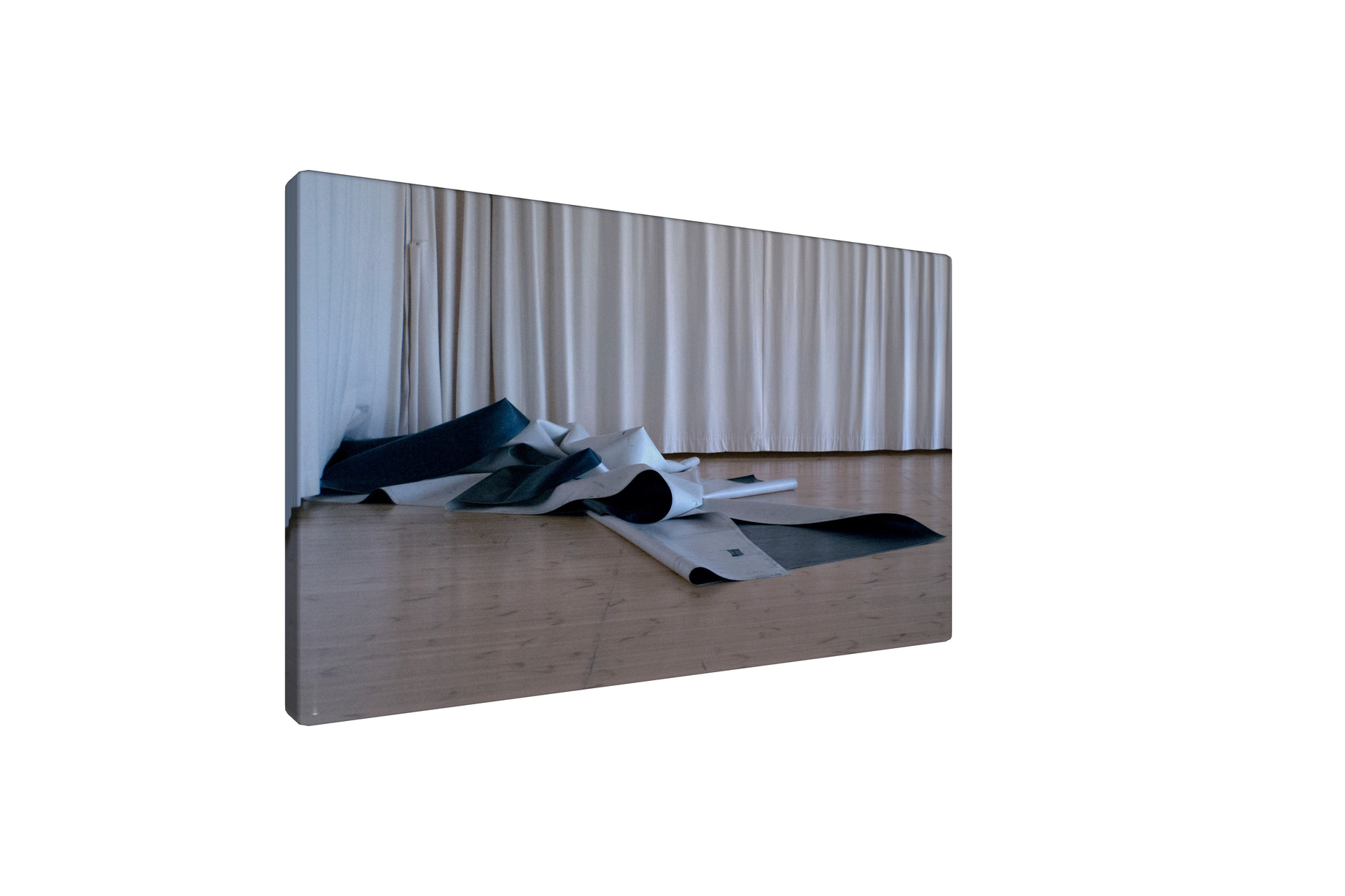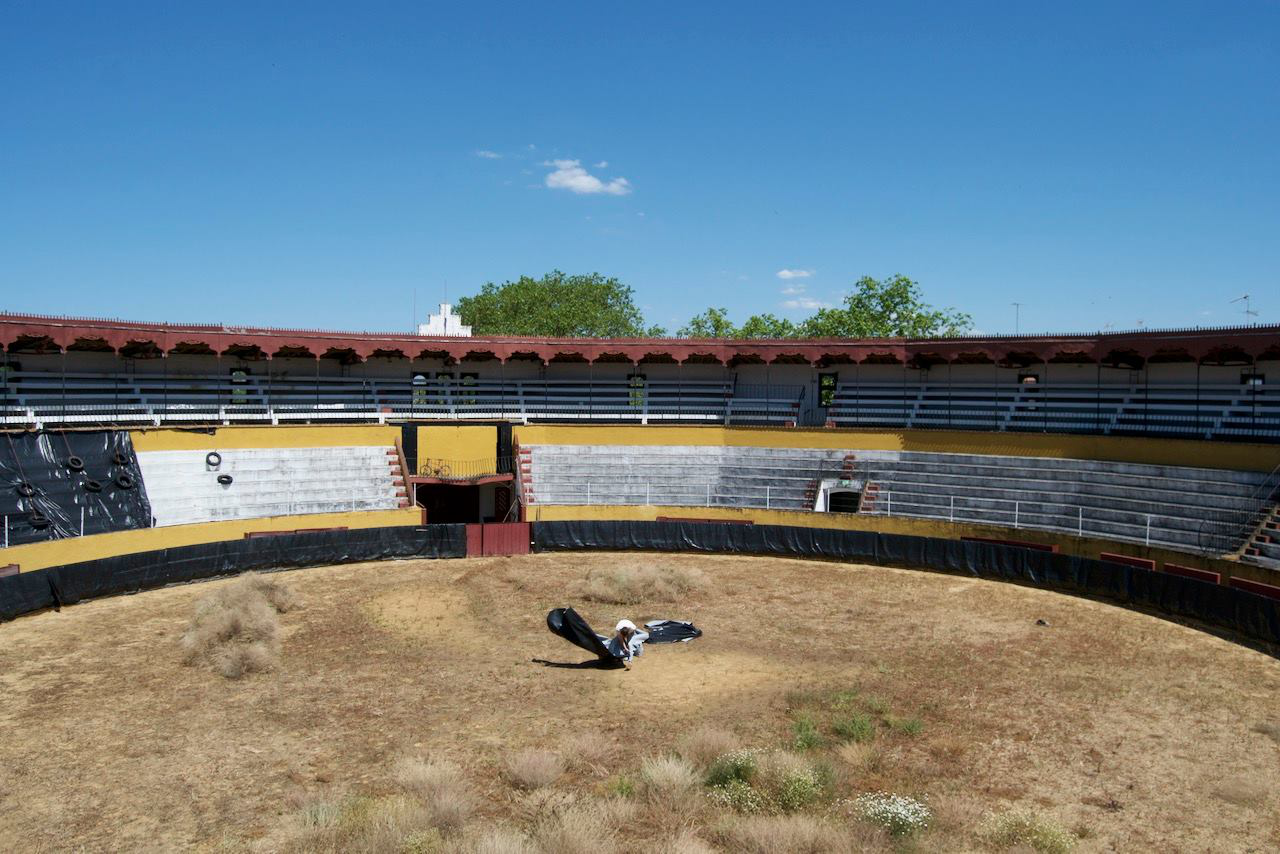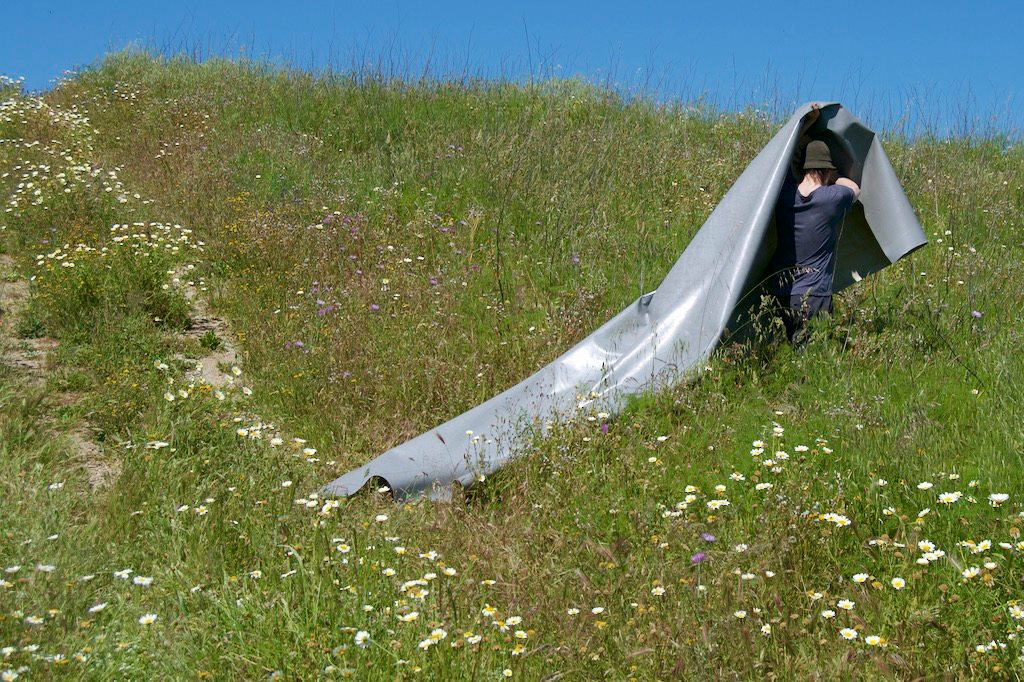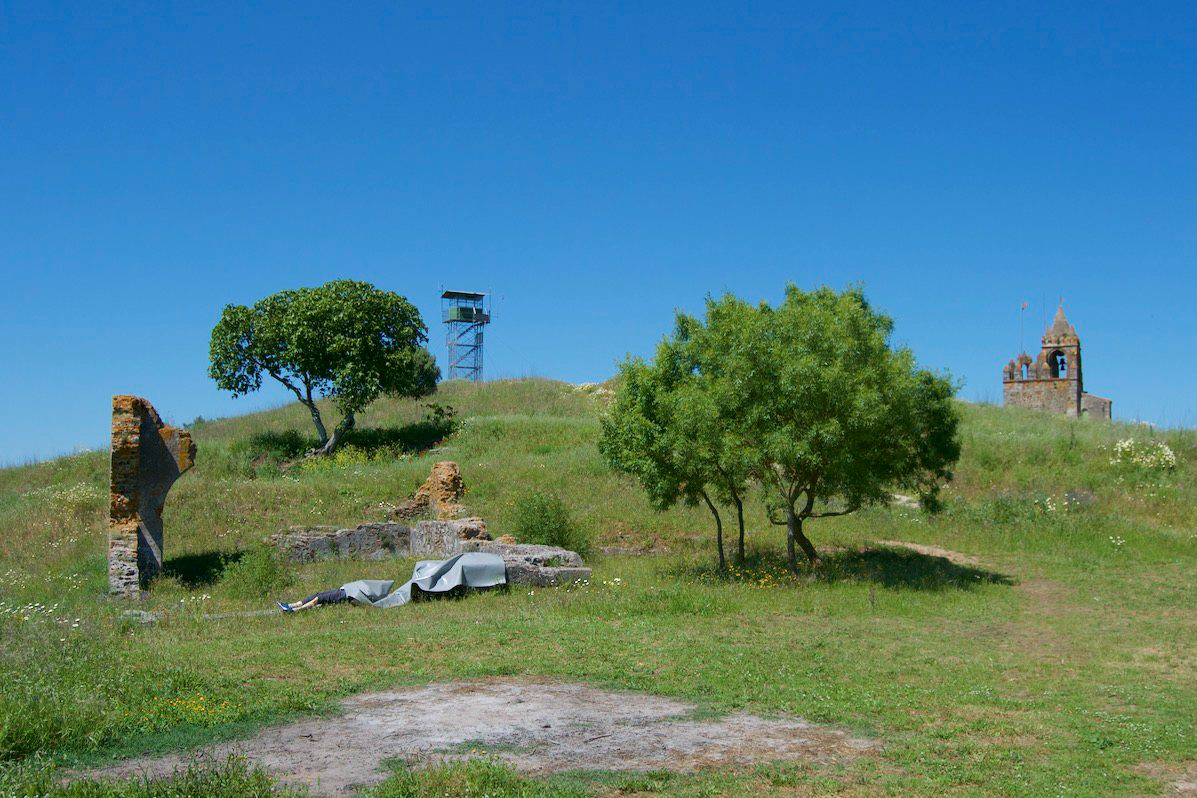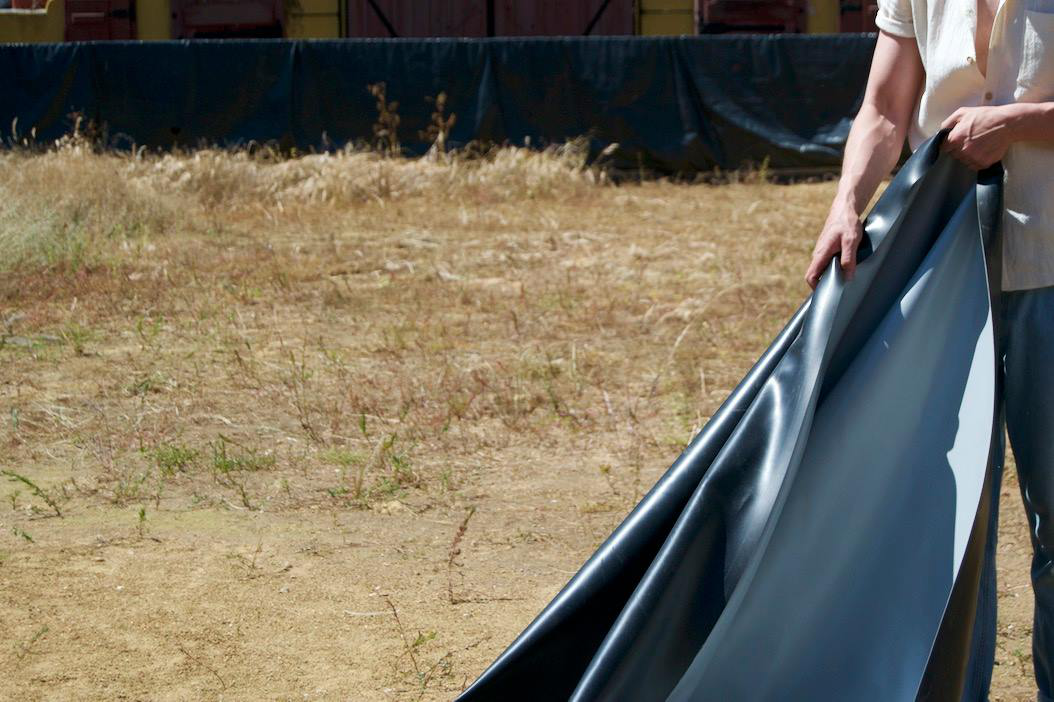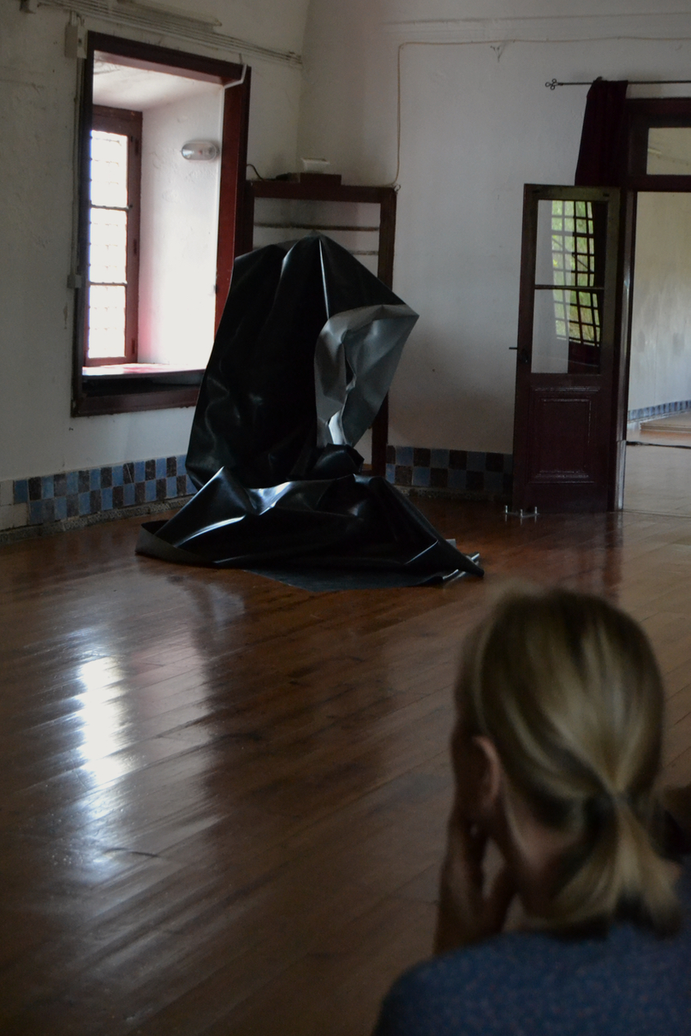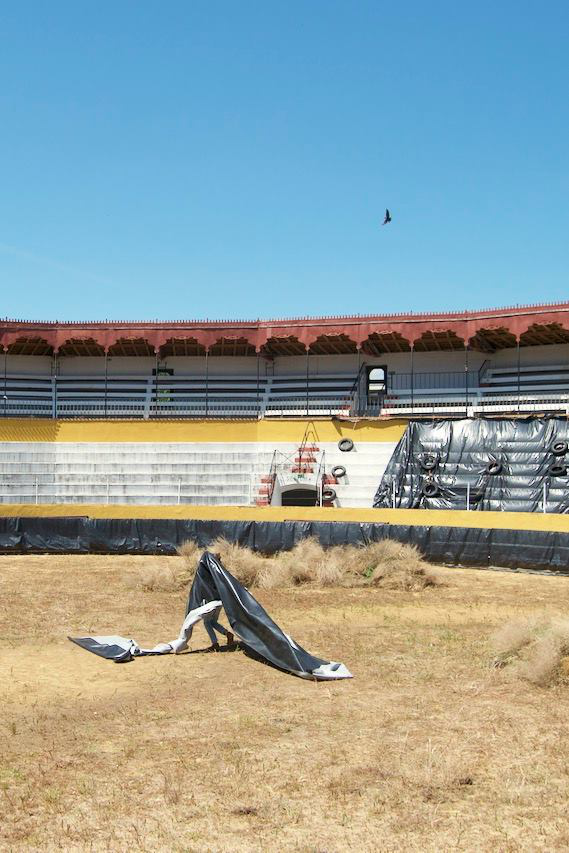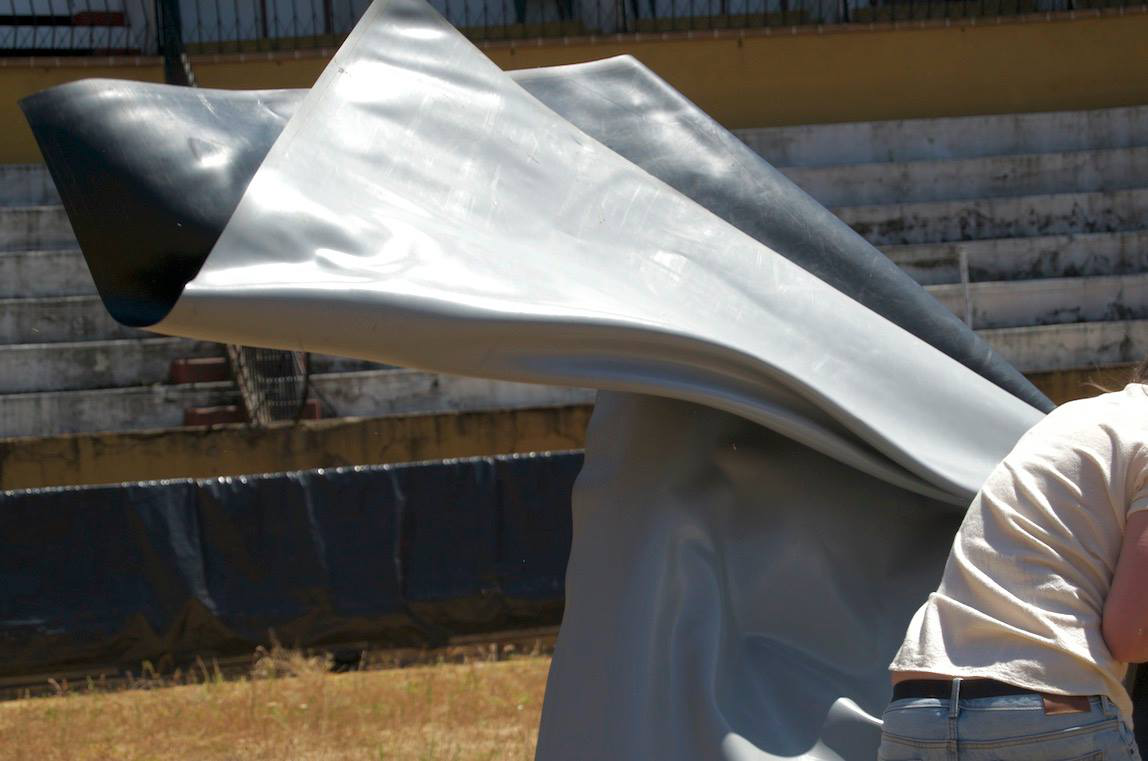A Dance Mat: from the studio to a bull-fight arena
The project A Dance Mat started as a workshop proposal for the Carpa4 colloquium on Artistic Research in Performing Arts, which was held in Helsinki 11.–13.6.2015. The title of the colloquium was The Non-Human and the Inhuman in Performing Arts – Bodies, Organisms and Objects in Conflict.
Due to the framework of the colloquium, I decided to propose a workshop that would take a closer look at a dance mat, which is an object onto which I have literally rubbed my body for years while studying dance and working in dance studios. Since the colloquium took place at the Theatre Academy where the dance studios are mostly covered by dance mats, the proposal was motivated by this conceptual, material, and spatial context. I wanted to see what this material choice in this context would produce, and I wanted to gather some feedback and information from the participants in order to test how this project could be developed. My proposal for Carpa4 was as follows:
revolutionary abstraction rolled utopia bulldozing cliché rubbed atlas something else
This workshop proposal in Carpa is approached through working with the material circumstance of the dance studio in Theatre Academy where Carpa takes place, instead of giving a participant a report of an external research project in the given studio. Studio is thought here as a multidirectional and layered social and material processual entity and it is thought of as a common working-space of my discipline, choreography.
In order to contribute to Carpa’s theme, the focus here is in one particular material condition often used in the dance-studios: A dance mat. A dance mat is a techno-industrial object, which is at the same time physical, lived, mental and conceptual. It offers a plane, which rubs off and erases the characteristics of the surface beneath it attempting to homogenize the surface of the space. It aims to offer a feeling of safety and it is supposed to be an ideal plane to work. It lifts the bodies above the messy and noisy ground. It aims to offer neutralized and atemporal topography where the body is put, thrown and positioned on. The dance mat aims to open a place, which is nowhere and at the same time it has a possibility to interact with all places from e.g. ballet, butoh and belly-dance. Literally, the sensuous body is rubbed against a dance mat.
With this thinking above, the focus of the workshop here in Carpa is to explore the affective relation between a body, a dance mat and movement. What kind of aesthetics the mat brings out and what is in- and excluded when we get in touch with it?
Project questions
In this project, I have been interested in studying questions such as: What kind of subject does this object produce? What kind of body does this object bring out? Who is used and how? Who or what is moved and how? Who or what is choreographed and how? How does the choreographic emerge and operate between materiality and corporeality? What does this object do in studios and on stages? If the dance studio has a dance mat, does the dance mat dominate my somatic life as a ground onto which I step? What kind of a sphere does this ground produce? Does it produce a will to move smoothly and become a virtuosic body, or what kind of moving does it support? What kind of an ideological plane it is?Initially, the project was contextualized in the realm of dance and in my history as a dance student at the Theatre Academy and a freelance choreographer, but the contextualization expanded when the project developed.
The workshop
At Carpa4, in the beginning of the workshop, I briefly introduced the history of the dance mat through the information I had received after contacting one of the main manufacturers of dance mats and floors in Europe, Harlequin Floors. In order to activate the workshop as an experimental situation with the participants and co-researchers, I chose four perspectives to approach the dance mat with: 1) the sacred (dance mat with high terms and conditions for use), 2) obedience (referring, e.g., to dance education), 3) resistance (materiality of the object) and 4) conflict (how the body is literally rubbed on the mat).
For each viewpoint, I facilitated a five-minute action and intervention in which the participants could engage; they were also free to just observe as I went through these actions. The chosen actions were:
The sacred: to spend time quietly with the dance mat, leaving it untouched. The dance mat was erected upright as a roll in the middle of the studio.
Obedience: repeatedly pushing the erected, upright, dance mat so it fell to the floor.
Resistance: throwing the dance mat into the air.
Conflict: unrolling the dance mat and rubbing the body on and against it.
The workshop ended with a short discussion after the facilitated actions. Some of the participants were familiar with the dance mat as an object and others were not. The discussion travelled from the personal, previous, lived experiences to more conceptual ponderings about the dance mat. The choice of the concepts to approach the dance mat and their impact on what happened and their echo to broader social implications were discussed.
The aim of the workshop was to think about the dance mat’s instrumentality and materiality in practice and to test it with chosen actions in relation to the human body and choreography. The tryout was referenced, for example, with the ongoing research interests for new materalism’s mode of inquiry, which aims to reorientate the ways of thinking about matter and materiality (see, i.e., Coole and Frost 2010, Introduction). The proposal was also influenced by affect-theory (see, i.e., Gregg and Seigworth 2010, pp. 1–29) and ponderings about the relations between choreography, a human body, and an object (see, i.e., Lepecki 2012).
The workshop functioned as a testing ground for further possibilities of A Dance Mat to be developed for the first artistic part of the doctorate. With the choices, try-outs, and discussions done within the theme of Carpa 4, I found this experience an encouraging one to keep this project in process and to develop it further and to focus on experimenting with its materiality.
A Dance Mat in the first artistic part
After the workshop at Carpa4, I decided to develop this project and include it in the first examined artistic part. In the first artistic part, I spent four hours per day with the dance mat in dance studio 702 at the Theater Academy. Spectators were free to come and go, to observe, to participate in the exploration, or to discuss the project with me. Based on the feedback that I received from external examiner Victoria Perez-Royo, during the days of the first artistic part, I threw away the perspectives with which I had approached the dance mat. This released me to experiment with the materiality of the dance mat more broadly, and I think, artistically, the proposal moved in a meaningful direction. The choice to drop the chosen viewpoints fastened the choreographic-material inquiry in a way that I started to focus on being more in diverse physical contact with the object. The inquiry started to develop towards the entanglement of a living sculpture, dance, choreography, and performance in which the dance mat was offering and proposing endless forms, movements, and shapes.
After the first artistic part, the process with the dance mat continued at the O Espaco do Tempo residency in Monte-Mor-o-Novo in Portugal from 17.5–31.5.2016. I continued playing with the mat outside of the studio conditions. By taking the object outdoors, the project took on more environmental emphasis. In the warm, sunny weather, the quality of the dance mat changed; it became liquid, soft, and heavy. After few experiments outdoors, in the area surrounding the residency, I decided to take the mat to the abandoned bullfighting arena, which was close to the residency. There, with the help of my collaborator Vincent Roumagnac, I made the video called A Matfighter.
I think the video collects the projects’ potential from Carpa4 to the first artistic part. The project is still ongoing. In 2017 I experimented with the dance mat in Helsinki and in Coventry (UK), where I collaborated with Paula Kramer and Nigel Clark. In 2018 I also performed the project in Karlsruhe in Germany in a symposium called Tanz der Dinge / Things that Dance, organized by the German Society of Dance Research. At the time of writing this commentary, I don’t know how the project will be further developed.
Outcomes
Throughout the whole doctoral research project, the dance mat project has continued my exploration of the relations between my body, material objects, and choreography. I can clearly link dance mat with the project Hiding. The common denominator is my interest in how the surrounding material choreographs my body and what kind of body the material surrounding produces. To inhabit these questions is a choreographic process, as can be seen from the works. Historically, the project contributes to questioning and destabilizing what Andre Lepecki calls the manipulative subject (Lepecki 2012, p. 76). From this perspective, according to Lepecki, other bodies are seen as ready for a choreographer’s manipulation, mere instrumental tools. A Dance Mat gives the specific object an alternative agency from its typical use, and when the agency of this object changes, so does the role of the choreographer who engages with it.
In the project, I wanted to take the manipulation of the dance mat very far physically, meaning that in the video A Matfighter, it is my body that gets exhausted by the dance mat. The object itself provides endlessly interesting forms, and my body can no longer intentionally instrumentalize the mat; instead my choreographic agency, understood as a manipulator, becomes an insufficient operative position. It is emptied out, and another kind of choreographic agency emerges. That agency is codetermined with the engagement with the dance mat, and this choreographic agency constantly evolves, depending on how the dance mat keeps transforming. The process strongly activates my imagination, and new, unexpected ways to engage with the dance mat emerge. That is the result of this project for me. It opens new choreographic relations between my body, this specific object, and broader surrounding material. From the studied reading theories, I can refer to the hyper-reading strategy of juxtaposing as a choreographic stance in which I develop another kind of choreographic agency compared to my previous practice. In this stance, my body can be thought of as being in a constant state of distraction (see Hayles 2010, p. 67) caused by the dance mat. In the project, it is up to me how long I negotiate with this state, but usually when performing I have framed the engagement with the dance mat between an intense 20 minutes to a looser couple of hours.
The importance of A Dance Mat in the development of my research process and artistic practice lies in reorganizing effects of the operative elements of the relations that my artistic practice is based on. By choosing one element from the plurality of the dance studio elements, it has been a way for me to reposition myself with something that I previously took as given, namely the dance studio as a working space for planning choreography.
This project is significant in my artistic history of stepping from indoors to outdoors, and I consider this project a threshold between those two spatial realms. Outdoors, the dance mat still carries indoors, and indoors it is on its way elsewhere.
